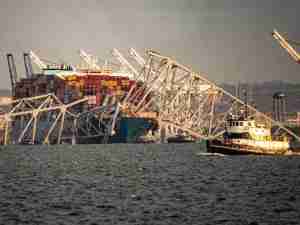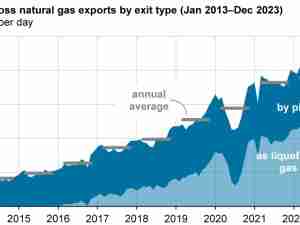North Korea Keeps Sneaking in Oil With Secret Ship Transfers
By: Serene Cheong and Dan Murtaugh | Jan 04 2018 at 03:52 AM | Maritime
Donald Trump’s desire to squeeze Kim Jong Un’s regime risks being undermined by the furtive maneuvers of oil tankers at sea.
The enforcement of international measures limiting sales to North Korea—part of an effort to force Kim to abandon nuclear weapons—is becoming near impossible because suppliers of illicit fuel are using an old oil-trading practice that helps obscure its origin and destination.
Ship-to-ship transfers, when cargoes are pumped from one tanker to another in the ocean, are legal and typically used to break up large oil shipments into parcels on smaller vessels. But they can also be used as a trick that makes it difficult to track supplies, and have been barred by the United Nations for sales to North Korea.
And even if the tankers can be identified, seized and inspected, culprits are hidden under layers of ownership. A controversy that erupted last week over a shipment of fuel to the rogue nation has so far entangled the world’s third-biggest independent oil trader, a Hong Kong-based commodity company and mysterious shipping firms in Taiwan and the Marshall Islands. South Korean authorities have failed to identify the perpetrator and on Thursday said they are still investing who owned the cargo.
“These STS transfers can happen 200 nautical miles or more out at sea, as long as conditions are calm, where no one’s looking,” said Rahul Kapoor, an analyst with Bloomberg Intelligence in Singapore. “It’s very easy to black out a ship and hide it.”
All ocean-going ships are equipped with a beacon that broadcasts their location around the world, so if a vessel tried to directly load or discharge oil in a sanctioned country, it could be identified. To get around that, two tankers can turn off their transmitters, known as the automatic identification system, rendezvous in secret and transfer the cargo, masking the true origin and destination of the shipment.
A vessel, the Lighthouse Winmore, is said to have transferred 600 tons—about 4,000 barrels—to a North Korean vessel, the Sam Jong 2, on Oct. 19.
Ship-tracking data compiled by Bloomberg showed Lighthouse Winmore making trips between Kaohsiung in Taiwan and Yeosu in South Korea during September and October.
The vessel data, which are broadcast by ships voluntarily and cannot be independently verified, showed it south of Yeosu, with its destination listed as Taichung, Taiwan, on Oct. 15. The ship stopped reporting its location for the next 10 days, virtually disappearing during the period of the alleged transfer. The next transmission was Oct. 25, further to the south near Jeju Island.
While STS transfers are an integral part of the oil and fuel-trading business, “when in the wrong hands, this every-day operation can be misused,” said Den Syahril, an analyst at industry consultant FGE in Singapore. “During past sanctions, there’s a possibility that ships with Iranian fuel turned off their trackers and conducted these operations in the Middle East gulf, only to have the cargo labeled as Middle East origin afterwards.”
Controversial Trades
Now that the practice is in the spotlight, it may become harder to get away with it. Reports that U.S. satellites have been capturing Chinese ships transferring fuel to North Korean vessels could deter perpetrators while major oil trading companies may take additional precautions not to be involved in the controversial transactions.
On Tuesday, South Korea’s foreign ministry said Trafigura Group owned the Lighthouse Winmore cargo and authorities were investigating whether it ordered the transfer to North Korea. Within a few hours, the trading house denied it was involved in the illicit transaction, saying it neither owns nor chartered the ship.
Trafigura added that it originally sold the cargo to Hong Kong-based Global Commodities Consultants Ltd., which in turn said it sold the shipment to another company called Oceanic Enterprise Ltd. Both Trafigura and GCC said their contracts stipulated that any resale of the supply must abide by international sanctions.
No contact information was immediately available for Oceanic Enterprise. South Korea identified Lighthouse Winmore’s charterer as Taiwan-based Billions Bunker Group. The company is incorporated in the Marshall Islands, according to Taiwan’s Maritime and Port Bureau.
Risk Management
Taiwan is investigating if the head of Kao Yang Fishery Co. has any connection with the Lighthouse Winmore, according to a Kaohsiung District Prosecutors Office statement on Jan. 3. Kao Yang allegedly sold oil products in international waters instead of Hong Kong, which was identified in export declaration as its destination, according to the statement.
“Trading houses have full teams that are involved in risk management,” said Bloomberg Intelligence’s Kapoor. “Ideally, these teams will screen through counterparties, and it’s unlikely that they’ll dabble in a one-off illegitimate dealing for a small profit as there’s so much risk to reputation involved.”
China refused to designate Lighthouse Winmore and Sam Jong 2, among other ships, as sanctions violators in a disagreement with the U.S., the Wall Street Journal reported last week. While American officials shared with the UN declassified intelligence reports that they said supported Washington’s position that 10 vessels be formally declared as breaching measures, China successfully got the list whittled down to just four tankers, the newspaper said, citing unidentified diplomats.
U.S. President Trump last week tweeted: “Caught RED HANDED - very disappointed that China is allowing oil to go into North Korea. There will never be a friendly solution to the North Korea problem if this continues to happen!”
Spy Satellites
American spy satellites had observed Chinese vessels allegedly transferring oil to North Korean ships in the sea between the two countries about 30 times since October, Seoul-based newspaper Chosun Ilbo reported Dec. 26, citing unidentified South Korean government officials. China has denied the reports.
The vast majority of ship-to-ship transfers are legal. Most of them take place in the U.S. Gulf of Mexico, where the practice is also known as lightering. It’s cheaper to ship oil on larger vessels, so oil traders tend to book the biggest vessel they can find for long haul journeys such as from Saudi Arabia to Texas.
U.S. ports aren’t deep enough to handle the massive tankers, so they stop a few miles from shore and parcel out the oil to smaller ships that are able to dock. The transfers are common enough that most merchant seamen can do them, said Kapoor, who spent five years working on an oil tanker.
But “even with mounting international sanctions on countries such as North Korea, these operations are often attempted as a way to get around them,” FGE’s Den said.









_A_-_28de80_-_38f408a0a1c601cdbf9fe70c9d30a28084a5da3d_lqip.jpg)
